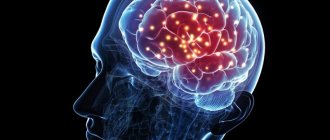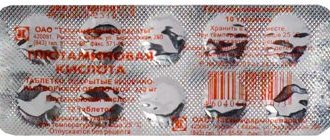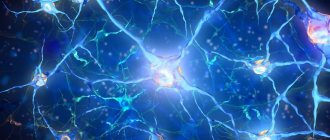| Panic disorder | |
| ICD-11 | 6B016B01 |
| ICD-10 | 41.041.0 |
| ICD-10-CM | F41.0 |
| ICD-9 | 300.01300.01, 300.21300.21 |
| OMIM | 167870, 607853 and 609985 |
| DiseasesDB | 30913 |
| MedlinePlus | 000924 |
| MeSH | D016584 |
| Media files on Wikimedia Commons | |
Panic disorder
or
episodic paroxysmal anxiety
is a mental disorder characterized by the spontaneous occurrence of panic attacks several times a year to several times a day and the anticipation of their occurrence. A characteristic feature of the disorder is recurrent attacks of severe anxiety (panic), which are not limited to a specific situation or circumstances and, therefore, unpredictable[1].
Another name for this disease is episodic paroxysmal anxiety.
.
Before the widespread use of ICD-10, this disease, depending on the leading symptom, was called differently: “cardioneurosis”, “VSD (vegetative-vascular dystonia) with a crisis course”, “NCD (neurocirculatory dystonia)”
.
Clinical picture and diagnostic criteria[ | ]
People with panic disorder typically experience a series of intense episodes of extreme anxiety called panic attacks. Panic attacks usually last about 10 minutes, but can be short-term - about 1-5 minutes, and long-lasting - up to 30 minutes, while the feeling of anxiety can persist for 1 hour. Panic attacks can vary in the set of symptoms or be of the same type (that is, tachycardia, sweating, dizziness, shortness of breath, tremors, experiencing uncontrollable fear, etc.). In some patients, these conditions are observed regularly - sometimes daily or weekly. The external symptoms of a panic attack often lead to negative social consequences (eg, embarrassment, social stigma, social isolation). However, patients who are aware of their illness can often have intense panic attacks with very little external manifestations of this condition.
A special scale is used to determine the severity of panic disorder; it also exists in the form of a self-esteem questionnaire as a test for panic attacks[2][3].
Diagnostic criteria ICD-10[ | ]
- Repeated, unpredictable attacks (not limited to any specific situation) of severe anxiety (panic).
- Autonomic pain symptoms accompanying anxiety, derealization and depersonalization.
- Secondary fears of death and madness.
- Secondary avoidance of any situation in which the panic attack first occurred.
- Secondary fears of loneliness, crowded places, repeated panic attacks.
- Panic disorder is the primary diagnosis in the absence of any phobia as a primary disorder ( otherwise, a panic attack is considered a sign of a full-blown phobia
). - A reliable diagnosis of panic disorder requires that several severe anxiety attacks
observed at least
within one month
and met the following requirements:- Panic disorder occurs under circumstances not related to an objective threat ( anxiety of anticipating an attack is possible
). - Panic disorder is not limited to a known, predictable situation.
- Availability of anxiety-free periods between attacks.
DSM-IV Diagnostic Criteria[ | ]
- A.
- Recurrent panic attacks.
- At least one attack occurred for 1 month (or more) with the following additional symptoms:
- Continued concern about seizures.
- Worry about the consequences of the attack (for example, fear of loss of self-control, myocardial infarction, fear of going crazy).
- Significant changes in behavior associated with attacks.
- B. Presence (or absence) of agoraphobia.
- C. Symptoms are not due to direct physiological effects of a substance (eg, drug abuse, medication) or a medical condition (eg, hypertension, hyperthyroidism, pheochromocytoma, etc.).
- Symptoms cannot be explained by the presence of another mental or behavioral disorder, such as somatoform autonomic dysfunction of the heart and cardiovascular system, hypochondriasis, social phobia, other phobias, obsessive-compulsive disorder, post-traumatic stress disorder, or separation anxiety disorder.
According to the Diagnostic and Statistical Manual DSM-IV-TR, panic attacks are not considered as a separate disease, but are included as part of the diagnosis of other anxiety disorders[4].
Differential diagnosis[ | ]
Panic disorder must be distinguished from a number of somatic diseases and conditions, which include cardiovascular disorders, chronic obstructive pulmonary diseases, some endocrine and metabolic disorders (Cushing's disease, electrolyte disorders, hyperthyroidism, hyperglycemia, diseases of the parathyroid glands), epilepsy, especially temporal; peptic ulcer, pheochromocytoma, pulmonary embolism[5], vestibulopathies, central nervous system tumors, bronchial asthma, effects of certain drugs and narcotic substances[6], conditions after severe burns and extensive surgical interventions.
In addition, panic disorder should be distinguished from other mental disorders that cause panic attacks: for example, identified phobic disorders (F40.x), post-traumatic stress disorder, obsessive-compulsive disorder, somatoform disorders (F4x.x) and other similar disorders. Panic attacks may be secondary to depressive anxiety spectrum disorders, especially in men, and if criteria for depressive disorder are met, panic disorder should not be established as the primary diagnosis.
Causes of acute psychosis
Experts have found that acute psychosis develops under the influence of both external and internal causes. If a patient at the Yusupov Hospital is diagnosed with acute psychosis, treatment is carried out according to an individual program drawn up in accordance with the root cause of the disorder.
External causes of acute psychosis are:
- infectious diseases;
- psychological trauma;
- traumatic brain injuries;
- use of drugs or large doses of alcohol.
The internal factors of acute mental disorder are:
- hereditary predisposition to the development of mental illness;
- mental and somatic diseases;
- age-related changes.
Numerous studies indicate that adolescents and older people are most susceptible to the development of acute psychosis, which is associated with hormonal changes in the body. In addition, the likelihood of developing mental disorders increases with injuries and infectious diseases inflicted on the body. Reactive psychosis is also common among women who have experienced the death of a child or abortion.
Acute psychosis, the symptoms of which differ from other types of mental disorders, its mechanisms and methods of treatment are studied by psychiatrists at the Yusupov Hospital. If signs of reactive psychosis appear, you should be examined in a modern diagnostic center and consult a highly qualified psychiatrist. The danger of self-treatment of psychosis lies in the high likelihood of developing various forms of deviant behavior.
Course and prevalence[ | ]
Panic disorder usually begins at a young age, less often in childhood and adulthood. According to research results, about 1.7% of the US adult population had symptoms of panic disorder (women are 2-3 times more likely to get sick). The disease has a wavy course; about half of the patients generally recover, the rest lead a relatively normal life, despite the persistence of symptoms and the presence of relapses.
The protracted course of panic disorder is facilitated by inadequate and untimely treatment measures. Anxiety disorders, including panic, are diagnosed in only 50% of patients with obvious symptoms. Fewer than 50% of patients receive any treatment and less than 30% receive adequate therapy.
Signs of generalized anxiety disorder
Not every person with generalized anxiety disorder has the same symptoms as another. As discussed, symptoms can vary greatly, but most people with GAD experience a combination of the following emotional, behavioral, and physical symptoms.
Emotional symptoms of generalized anxiety disorder
- Constant worries running through your head
- Anxiety is uncontrollable, there is nothing you can do to stop the anxiety
- Intrusive thoughts that create anxiety; You try not to think about them, but you can't
- Intolerance of uncertainty; You must know what will happen in the future
- Widespread (pressing) feeling of apprehension or dread
Behavioral symptoms of generalized anxiety disorder
- Inability to relax and enjoy peace of mind
- Difficulty concentrating
- Quitting activities because you feel depressed
- Avoiding situations that make you anxious
Physical symptoms of generalized anxiety disorder
- Feeling of tension in the body or part of the body, sensation of pain, heaviness, pressure
- Having trouble falling or staying asleep
- Feelings of extreme anxiety or nervousness
- Stomach problems, nausea, diarrhea
Treatment[ | ]
Despite the obligatory presence of autonomic dysfunction in an attack and the often implicit nature of emotional disorders, the main methods of treating panic disorder are psychotherapy and psychopharmacology.
Psychopharmacology[ | ]
SSRI antidepressants are used for a long time, at least 6 months; as well as tranquilizers (alprazolam, clonazepam) for a short course - up to 14 days.
For some time, highly potent benzodiazepines such as alprazolam and clonazepam were considered the first choice drugs for the treatment of panic disorder. But their lack of effectiveness against symptoms of depression, which often co-occurs with panic attacks, and significant side effects have reduced their popularity. SSRIs have become the first-line drugs of choice.[5]
In patients with a history of manic states, the use of benzodiazepines is preferable, since, unlike antidepressants, they do not provoke mania[6].
The use of so-called vegetotropic drugs (anaprilin, pyrroxan, belloid, bellaspon) in combination with vascular-metabolic therapy (cinnarizine, cavinton, trental, nootropil, piracetam, cerebrolysin) is ineffective, which undermines faith in the possibility of a cure and contributes to the chronicity of the disease.
Not all classes of psychotropic medications are equally effective against panic. With the right approach, panic disorder is highly treatable. An individual treatment plan is required for each patient, which should be developed by the patient together with his attending physician.
Psychotherapy[ | ]
Psychotherapeutic help (help from a psychotherapist or psychologist) for panic disorder can help to understand the psychological problem, see ways to solve it, and work through the psychological conflict.
Cognitive-behavioral psychotherapy has been proven effective in treating panic disorder[7][5][6][8] (including cognitive-behavioral psychotherapy delivered via the Internet[9]). According to a meta-analysis, in the treatment of panic attacks, cognitive behavioral psychotherapy had a higher effect size compared with pharmacological treatment and combination treatment (that is, psychopharmacotherapy in combination with psychotherapy). When using cognitive behavioral psychotherapy, fewer patients discontinued treatment compared to pharmacological and combination treatments[10]. There is evidence of greater anti-relapse activity of cognitive behavioral psychotherapy for panic disorder compared to pharmacotherapy[8]. Cognitive-behavioral psychotherapy also promotes successful discontinuation of benzodiazepines in patients with panic disorder and helps them maintain therapeutic benefits without resorting to medications[11].
In particular, within the framework of cognitive behavioral psychotherapy, the “thought stopping” method can be used to eliminate anxious thoughts that cause a panic attack [12]. A technique such as symptom replication in laboratory conditions can also be used[13]. The technique of symptom replication in the laboratory is that, using various techniques (Clark hyperventilation, the use of caffeine, or quickly climbing stairs), some of the physiological components of a panic attack are reproduced - sweating, rapid heartbeat, etc. Then the interpretations that arise in the patient are revealed these physical sensations and emotional reactions. If the patient correctly interprets the sensations that have arisen, the psychotherapist draws his attention to the connection between the interpretation and the emotional state (“You now explain the heartbeat as running up the stairs, and not as a heart attack, and you are absolutely calm”). The therapist also suggests that the patient look for an alternative explanation for the palpitations in everyday life, instead of believing that the palpitations are a clear sign of a heart attack, and rely on laboratory experience in doing so.[13]
As part of cognitive behavioral psychotherapy, the patient may also be taught relaxation skills and Clark's controlled breathing techniques during therapeutic sessions, after which the patient is recommended to use these skills in the intervals between sessions, during episodes of intense anxiety [13].
Psychoanalysis is also used in the treatment of panic disorder. From the point of view of psychoanalysts, the main cause of panic disorder is considered to be repressed psychological conflicts that do not find a way out and cannot be recognized and resolved by a person due to various reasons.
Acute psychosis: ICD-10 code
The World Health Organization has developed the ICD-10 classification of diseases, which is used in setting and coding medical diagnoses. This classification includes acute psychosis, the ICD-10 code for which is assigned F23, which combines acute and psychotic disorders into one group.
Psychiatrists at the Yusupov Hospital have many years of experience in treating mental disorders, in particular acute psychosis, the development of which occurred under the influence of various factors. In some cases, the patient does not realize and does not accept reality, then the only correct decision is to undergo a course of therapy and subsequent restoration of his mental state in the Yusupov Hospital.
Theories about the origin of the disease[ | ]
- Serotonin theory
- data on the role of serotonin in the pathogenesis of panic disorders were obtained in pharmacological studies. Studies of neuroendocrine reactions in response to the administration of serotonergic drugs have revealed certain changes in patients with panic disorders (changes in cortisol secretion in response to the administration of fenfluramine and meta-chlorophenylpiperazine). It is possible that platelet levels of serotonin-related protein are altered in patients with panic disorder. Research has also been conducted on the connection between panic disorder and the production of antibodies to serotonin. The interaction of the serotonergic and other neurotransmitter systems is important. The connection between the serotonergic and noradrenergic systems helps explain the disruption of autonomic regulation in panic disorder. SSRIs may also reduce symptoms of panic disorder indirectly through their effects on the noradrenergic system. For example, fluoxetine can normalize the MHPG response to clonidine in patients with panic disorder. - Respiratory theories
— explain the occurrence of panic disorder by a failure in the regulation of breathing and the occurrence of an “emergency” reaction. A panic attack is triggered by excessive breathing through the activation of the supposed “center of suffocation.”- The neuroanatomical model suggests that a panic attack is associated with hyperactivation of brainstem structures, which manifests itself in changes in respiratory functions, dysfunction of serotonergic and norepinephrine structures. This model associates the remaining manifestations with disturbances in the functioning of other parts of the brain - limbic structures - anticipation anxiety, disturbances in the prefrontal cortex - restrictive behavior.
- Genetic hypotheses
- an attempt to determine the genetic loci responsible for the development of panic disorder remains unsuccessful to this day. Panic disorder often occurs in close relatives, which may indicate the role of heredity. Comorbidity with diseases such as bipolar affective disorder and alcoholism was also established. - Autonomic theories
are based on the study of cardiac indicators of the interaction of the parasympathetic and sympathetic systems and reactions to noradrenergic drugs (studies with clonidine). In adult patients, a flattening of the growth hormone secretion curve in response to the administration of clonidine was found, which indicates a decrease in the sensitivity of hypothalamic α2-adrenergic receptors; an increase in blood pressure and MHPG levels was also observed. With successful treatment of panic disorder, the normal response is restored in the form of a decrease in MHPG in response to clonidine administration.- Locus ceruleus model - with the administration of yohimbine and α2-adrenergic receptor agonists stimulating the locus ceruleus, an increase in anxiety is observed.
- Conditioned reflex theory
- presumably, any anxiety reaction arises as a result of the interaction of the amygdala with brainstem structures, the basal ganglia, the hypothalamus and cortical pathways. Internal stimuli are considered as conditioned stimuli that can trigger a panic attack. A panic attack occurs as a result of activation of neural pathways that provide a conditioned reflex phobic reaction in response to normal fluctuations in physiological functions. This theory is also confirmed by the fact that a conditioned reflex can be developed based on the respiratory and physiological response to inhaling carbon dioxide. - Cognitive theories
- A number of cognitive factors are hypothesized to influence the development of panic attacks. Patients with panic disorder experience increased anxiety sensitivity and a decreased threshold for perceiving signals from internal organs. These people report more symptoms when anxiety is provoked by exercise.
From anxiety to anxiety: from normal to disorder
Anxiety is a typical adequate response to stress, and it can be quite useful in some situations. This feeling warns us of danger, helps us prepare and concentrate.
Anxiety refers to the anticipation of a threatening event in the future and most often manifests itself in a person's muscle tension and avoidance behavior. Fear is an emotional response to an immediate threat.
- excessive anxiety
- inability to relax
- sleep problems,
- tachycardia, arrhythmia, slow heart rate,
- nausea,
- pain or pressure in the chest,
- "lump" in the throat,
- dry mouth,
- with ragged breathing,
- feelings of fear, inhibition, inability to control one’s own behavior,
- trembling, sweating, chills,
- feeling of detachment
- lightheadedness, dizziness,
- thoughts about death.
Everyone is capable of experiencing the symptoms described during stressful situations. However, individuals suffering from anxiety disorders are able to experience them in a calm environment, for no reason, together with more severe manifestations.
Notes[ | ]
- World Health Organization.
F4 Neurotic, stress-related, and somatoform disorders // International Classification of Diseases (10th revision). Class V: Mental and behavioral disorders (F00-F99) (adapted for use in the Russian Federation). - Rostov-on-Don: Phoenix, 1999. - P. 175-176. — ISBN 5-86727-005-8. - Shear MK, Brown TA, Barlow DH, Money R., Sholomskas DE, Woods SW, Gorman JM, Papp LA
Multicenter collaborative panic disorder severity scale. (English) // The American Journal Of Psychiatry. - 1997. - November (vol. 154, no. 11). — P. 1571—1575. - doi:10.1176/ajp.154.11.1571. - PMID 9356566. [] - https://goodmedicine.org.uk/files/panic,%20assessment%20pdss.pdf
- APA Diagnostic Classification DSM-IV-TR
- ↑ 1 2 3 Kasper Z., Zohar J., Stein D.
Decision making in psychopharmacotherapy / Transl. from English V. Shtengelov. - Kyiv: Sfera, 2006. - 136 p. — ISBN 966-8782-24-0. - ↑ 123
Pharmacotherapy in neurology and psychiatry: [Trans. from English] / Ed. S. D. Enna and J. T. Coyle. - Moscow: LLC: "Medical Information Agency", 2007. - 800 pp.: ill. With. — 4000 copies. — ISBN 5-89481-501-0. - Kaczkurkin AN, Foa EB
Cognitive-behavioral therapy for anxiety disorders: an update on the empirical evidence. (English) // Dialogues In Clinical Neuroscience. — 2020. — September (vol. 17, no. 3). - P. 337-346. — PMID 26487814. [] - ↑ 1 2 Gorodnichev A.V.
Current trends in the treatment of anxiety disorders: from scientific data to clinical recommendations // Biological methods of treatment of mental disorders (evidence-based medicine - clinical practice) / Ed. S.N. Mosolova. - Moscow: Publishing House "Social and Political Thought", 2012. - P. 643-668. — 1080 s. — 1000 copies. — ISBN 978-5-91579-075-8. - Hedman E., Ljótsson B., Rück C., Bergström J., Andersson G., Kaldo V., Jansson L., Andersson E., Andersson E., Blom K., El Alaoui S., Falk L., Ivarsson J., Nasri B., Rydh S., Lindefors N.
Effectiveness of internet-based cognitive behavior therapy for panic disorder in routine psychiatric care. (English) // Acta Psychiatrica Scandinavica. — 2013. — December (vol. 128, no. 6). - P. 457-467. - doi:10.1111/acps.12079. — PMID 23406572. [] - Kholmogorova A. B., Garanyan N. G., Nikitina I. V., Pugovkina O. D.
Scientific research into the process of psychotherapy and its effectiveness: the current state of the problem. Part 1 // Social and clinical psychiatry. - 2009. - T. XIX, No. 3. - P. 92-100. - Otto MW, Hong JJ, Safren SA
Benzodiazepine discontinuation difficulties in panic disorder: conceptual model and outcome for cognitive-behavior therapy. (English) // Current Pharmaceutical Design. - 2002. - Vol. 8, no. 1. - P. 75-80. - doi:10.2174/1381612023396726. — PMID 11812251. [] - Martha Davis, Elizabeth Robbins Eshelman, Matthew McKay.
The relaxation & stress reduction workbook. - Oakland, USA: New Harbiner Publications Inc., 2008. - 294 p. — ISBN 1-57224-214-0. - ↑ 1 2 3 Garanyan N. G.
Practical aspects of cognitive psychotherapy // Moscow Psychotherapeutic Journal. - 1996. - No. 3.
Diagnosis of acute psychosis in Moscow
When contacting the Yusupov Hospital with signs of acute psychosis, hospitalization and diagnosis are carried out. In this condition, a person can cause harm to himself and the people around him, so visiting the patient in a comfortable hospital is a necessary measure. After placing the patient, he is examined.
Signs of acute psychosis appear rapidly, they differ in intensity, so when they are studied by a specialist, a preliminary diagnosis can be made. Acute psychosis, the symptoms of which may interfere with the patient's awareness of the problem, requires identification of the causes in order to prescribe effective and safe treatment.
At the Yusupov Hospital, medical staff implement a comprehensive approach to treating patients with psychosis. Thus, if a concomitant disease is identified during the examination, psychiatrists will offer the patient measures for its correction and therapy.
The Yusupov Multidisciplinary Hospital has a modern diagnostic facility that allows it to identify both physical problems and mental disorders. Psychiatrists regularly improve their skills and master the latest diagnostic techniques.











